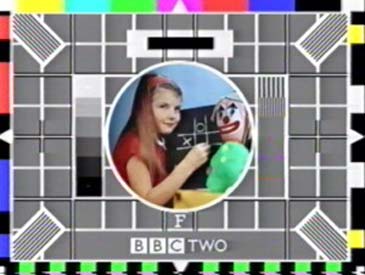
Have you seen this girl? Her name is Carol Hersee. This portrait of her is perhaps the most widely broadcast image in the history of television. Since it first appeared in 1967 on BBC2, Carol's face has been on-air for over 70,000 hours and is still in use today in over 30 countries. She used to appear regularly at the end of the daily broadcast schedule and accompany the sleepless (and the very patient) until programming resumed in the morning. With the advent of 24-hour programming, however, her schedule has been drastically reduced. As Carol joins the composing stick and the California type-case in the dustbin of design history, the public loses yet another tangible connection to the process of design and an oddly comforting reminder that culture is essentially a mechanical process.
This image of Carol is called Test Card F and was designed by her father George Hersee, an engineer for the BBC. As the name implies, this was not the first test card ever designed, nor was it the last. Test cards (or test patterns as they are called in the United States) are the descendants of tune-in cards, which were first broadcast in 1937. The tune-in card was used to identify the station, and to aid the viewer in fine-tuning their sets. Originally test cards were actual cards, usually hand-drawn and measuring two by three feet. Broadcasting a card required little besides holding it in front of a camera. The first test signal consisted simply of a large black cross on a white background. But as video technology evolved, circles, grids, diagonals, and converging lines were added and redrawn. These black and white graphics were essentially an optical obstacle course. Negotiating them was a quick way to test and adjust vertical and horizontal linearity (proportions), scanning linearity (even spacing of the scan lines), video frequencies (shadings), picture resolution (focus), interlacing (reducing flicker), and, finally, oscillation (especially at the corners, where picture quality is most likely to degrade).
These early graphic cards did not, however, address the most significant technical challenge that arose with the advent of color television. Suddenly, it became critical that cameras and televisions properly display flesh-tones. This was what led George Hersee to take some snapshots of his daughters, Carole and Gillian, for a mock-up of Test Card F. He did not think either of the girls would ever be on the air. He used Carol's picture simply to demonstrate to the management of BBC2 that a test card featuring a picture of a person would be the most useful graphic for adjusting the color performance of the channel's cameras and monitors. The management agreed, but they also decided that replacing the little girl in the mock-up with an adult model meant risking that the card would need costly updating to conform to the whims of grown-up fashion. So Carole was brought in for a proper photo shoot and the now famous photograph was taken.
Each of the props that surrounded Carole that day served a technical purpose. The chalk cross was positioned on the chalkboard to help engineers locate the center of the picture. Mr. Hersee once admitted that the BBC considered using a South Asian model with a bindi forehead marking for this purpose; apparently, the white cross on its black background proved more versatile. Because white images on television are made up of overlapping red, green, and blue, poor convergence of these colors shows up as "color fringing" on the cross. Even the somewhat unsettling clown has a purpose. Color televisions filter red, green, and blue signals from the black and white ones and decode them separately. This process causes the color signals to be delayed. If the black and white signals are not properly held back as well, a television suffers what is called a chrominance/luminance delay error. This causes the yellow of the clown's buttons to jump to the right, leaving the buttons themselves plain white.
Despite its functionality, Test Card F is seen less and less as the 24-hour programming day becomes the norm. Broadcast designers and editors still use test patterns to adjust color temperatures, but it is more and more rare for the average person to encounter this rough edge of the designed world. There are still little reminders: the "Not found" message that appears in a Web browser, the occasional "Searching for Satellite" screen on cable. But this default vocabulary has already been co-opted and reused by designers. Printers' marks and error messages have become commonplace design elements. Carol faces oblivion at best, and stylistic regurgitation at worst. In either case, a chapter of design history will be lost — the story of how a somewhat arbitrary, thoroughly constraint-driven process made a picture of a girl playing tic-tac-toe with a clown the most widely viewed show in the history of television.
Dmitri Siegel is a designer and writer living in Brooklyn. His writing has appeared in Dot Dot Dot, Emigre, and Adbusters; he also publishes Ante Magazine, a journal of visual culture. He is currently working on a history of feedback.
